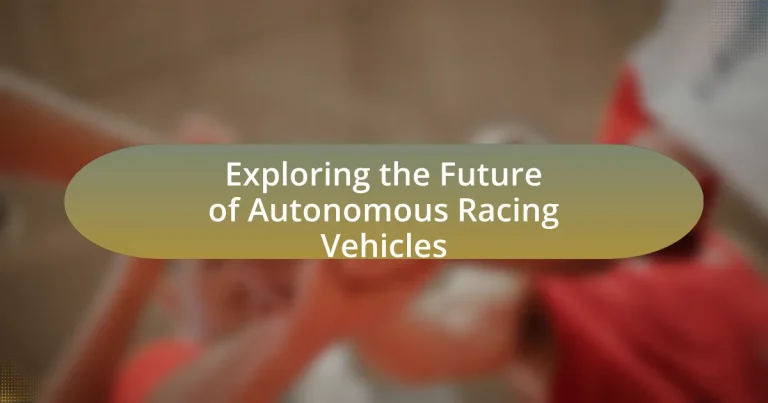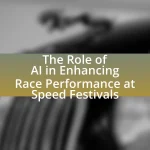Autonomous racing vehicles are self-driving cars engineered for competitive racing without human involvement, utilizing advanced technologies such as artificial intelligence, machine learning, and sensor systems. This article explores their operational mechanisms, including the integration of LIDAR, cameras, and radar for real-time decision-making and obstacle detection. It also examines the key technologies enabling their functionality, the role of safety systems, and the challenges faced in terms of reliability and regulatory compliance. Furthermore, the article highlights current advancements, testing methods, and the impact of these vehicles on the future of motorsports, including potential changes in competition dynamics and public perception.
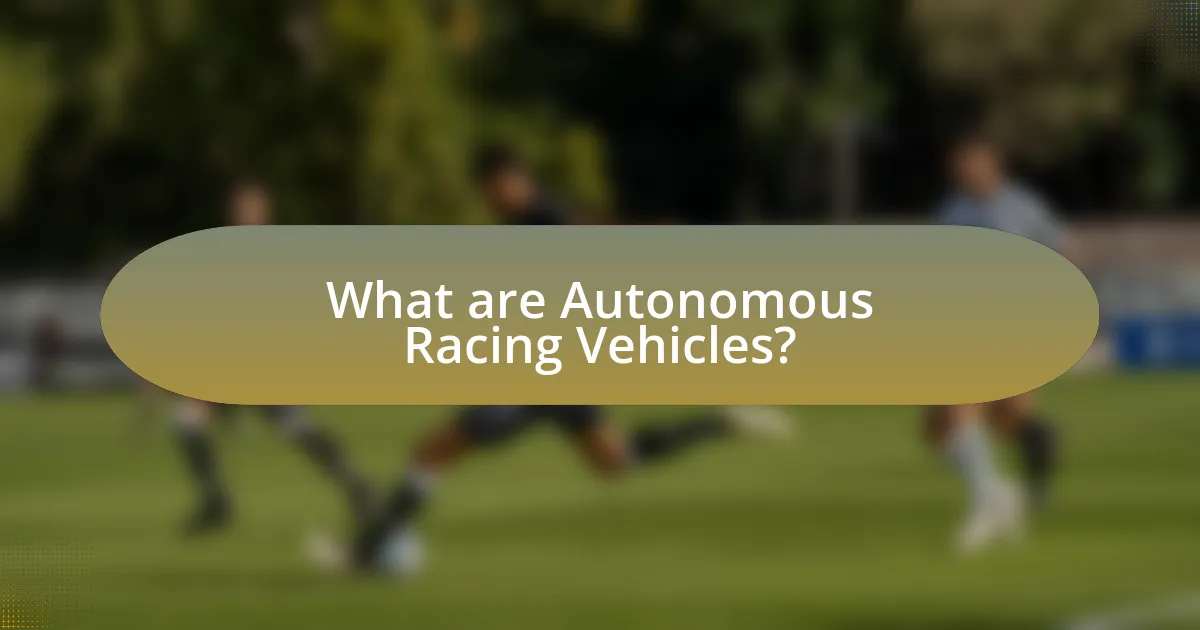
What are Autonomous Racing Vehicles?
Autonomous racing vehicles are self-driving cars specifically designed for competitive racing without human intervention. These vehicles utilize advanced technologies such as artificial intelligence, machine learning, and sensor systems to navigate tracks at high speeds while making real-time decisions. For instance, the Roborace series features fully autonomous electric race cars that compete against each other, showcasing the capabilities of autonomous driving technology in a racing environment.
How do Autonomous Racing Vehicles operate?
Autonomous racing vehicles operate using a combination of advanced sensors, artificial intelligence, and real-time data processing to navigate and compete on racetracks. These vehicles are equipped with LIDAR, cameras, and radar systems that provide a comprehensive view of their surroundings, allowing them to detect obstacles, track other vehicles, and assess track conditions.
The onboard AI processes this data to make split-second decisions regarding speed, steering, and braking, optimizing performance while adhering to racing strategies. For instance, during the 2020 Indy Autonomous Challenge, autonomous vehicles demonstrated their ability to navigate complex tracks at high speeds, showcasing the effectiveness of their operational systems.
What technologies enable the functionality of Autonomous Racing Vehicles?
Autonomous racing vehicles utilize a combination of technologies including artificial intelligence, machine learning, computer vision, LiDAR, radar, and advanced sensor systems. These technologies work together to enable real-time decision-making, obstacle detection, and navigation. For instance, artificial intelligence algorithms process data from sensors to predict and respond to dynamic racing conditions, while computer vision systems analyze visual inputs to identify track boundaries and other vehicles. LiDAR and radar provide precise distance measurements and environmental mapping, essential for safe maneuvering at high speeds. The integration of these technologies allows autonomous racing vehicles to operate effectively in competitive environments, demonstrating their capabilities in various racing scenarios.
How do sensors and algorithms contribute to their performance?
Sensors and algorithms significantly enhance the performance of autonomous racing vehicles by providing real-time data and enabling intelligent decision-making. Sensors such as LIDAR, cameras, and radar collect critical information about the vehicle’s surroundings, including obstacles, track conditions, and other competitors. This data is then processed by algorithms that analyze the information to make split-second decisions regarding speed, steering, and navigation. For instance, a study by the Massachusetts Institute of Technology demonstrated that advanced sensor fusion techniques improve obstacle detection accuracy by up to 30%, allowing for safer and more efficient racing strategies. Thus, the integration of high-quality sensors and sophisticated algorithms is essential for optimizing the performance of autonomous racing vehicles.
What are the key features of Autonomous Racing Vehicles?
Autonomous racing vehicles are characterized by advanced features such as real-time data processing, machine learning algorithms, and high-precision sensors. These vehicles utilize LIDAR, cameras, and radar to perceive their environment, enabling them to make split-second decisions during races. Additionally, they are equipped with sophisticated control systems that allow for precise maneuvering and speed optimization. The integration of artificial intelligence enhances their ability to learn from previous races, improving performance over time. These features collectively contribute to the vehicles’ capability to operate without human intervention, achieving high speeds while maintaining safety and efficiency on the track.
How do safety systems work in Autonomous Racing Vehicles?
Safety systems in Autonomous Racing Vehicles function by integrating advanced sensors, algorithms, and communication technologies to ensure the vehicle can navigate and respond to dynamic racing environments safely. These systems utilize LiDAR, cameras, and radar to detect obstacles, track other vehicles, and assess track conditions in real-time.
For instance, the vehicle’s onboard computer processes data from these sensors to make split-second decisions, such as adjusting speed or changing direction to avoid collisions. Additionally, safety protocols include redundancy measures, where critical systems have backups to maintain functionality in case of a failure.
Research indicates that these safety systems significantly reduce the risk of accidents; for example, a study by the University of Michigan found that autonomous systems can decrease crash rates by up to 90% compared to human drivers. This combination of technology and data-driven decision-making underpins the effectiveness of safety systems in autonomous racing.
What role does artificial intelligence play in their design?
Artificial intelligence plays a crucial role in the design of autonomous racing vehicles by enabling advanced decision-making, perception, and control systems. AI algorithms process vast amounts of data from sensors, such as cameras and LiDAR, to interpret the vehicle’s environment, identify obstacles, and predict the behavior of other competitors. For instance, companies like Waymo and Tesla utilize machine learning techniques to enhance their vehicles’ ability to navigate complex racing scenarios, optimizing speed and safety. This integration of AI not only improves performance but also allows for real-time adjustments during races, demonstrating its essential function in the evolution of autonomous racing technology.
What challenges do Autonomous Racing Vehicles face?
Autonomous racing vehicles face significant challenges including sensor reliability, real-time decision-making, and regulatory compliance. Sensor reliability is crucial as these vehicles depend on various sensors like LiDAR and cameras to perceive their environment; any malfunction can lead to catastrophic failures. Real-time decision-making is essential for navigating complex racing scenarios, where split-second choices can determine success or failure; studies show that even minor delays in processing can result in lost races. Regulatory compliance presents another hurdle, as varying regulations across different regions can complicate the deployment and testing of these vehicles, impacting their development timelines and operational capabilities.
How do regulatory issues impact the development of Autonomous Racing Vehicles?
Regulatory issues significantly impact the development of Autonomous Racing Vehicles by establishing safety standards, liability frameworks, and operational guidelines. These regulations dictate the technological advancements that can be pursued, as developers must ensure compliance with local and international laws. For instance, the National Highway Traffic Safety Administration (NHTSA) in the United States has issued guidelines that require extensive testing and validation of autonomous systems before they can be deployed in competitive environments. This regulatory landscape can slow down innovation, as companies must navigate complex legal requirements and potential liabilities associated with accidents or malfunctions. Additionally, differing regulations across regions can create challenges for manufacturers aiming for a global market, as they must adapt their technologies to meet varying legal standards.
What technical hurdles must be overcome for widespread adoption?
Widespread adoption of autonomous racing vehicles requires overcoming several technical hurdles, including safety, reliability, and regulatory compliance. Safety is paramount, as autonomous systems must demonstrate the ability to operate without causing accidents, which necessitates advanced sensor technology and robust algorithms for real-time decision-making. Reliability is crucial, as these vehicles must consistently perform under various conditions, requiring extensive testing and validation to ensure they can handle unpredictable scenarios. Regulatory compliance involves navigating complex legal frameworks that govern vehicle operation, necessitating collaboration with policymakers to establish standards and guidelines. These challenges are supported by industry studies indicating that addressing safety and reliability concerns is essential for consumer trust and regulatory approval, which are critical for market entry.
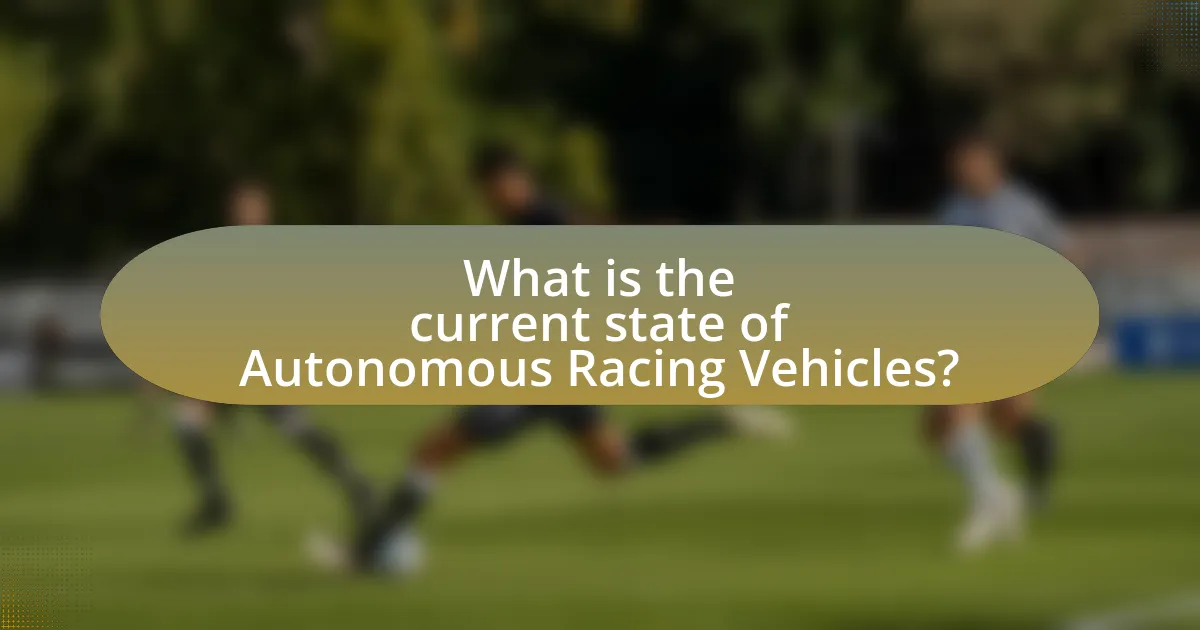
What is the current state of Autonomous Racing Vehicles?
The current state of Autonomous Racing Vehicles is characterized by significant advancements in technology, with several organizations actively developing and testing fully autonomous racing systems. Companies like Roborace and the Indy Autonomous Challenge have conducted successful events showcasing vehicles that can navigate complex tracks without human intervention. These vehicles utilize advanced algorithms, machine learning, and sensor technologies to make real-time decisions, demonstrating capabilities such as high-speed cornering and obstacle avoidance. The ongoing research and development in this field indicate a growing interest in the potential applications of autonomous technology in both motorsport and commercial sectors.
How are Autonomous Racing Vehicles being tested today?
Autonomous Racing Vehicles are being tested today primarily through a combination of simulation environments and real-world track testing. These vehicles utilize advanced algorithms and machine learning techniques to navigate complex racing scenarios, allowing engineers to refine their performance in a controlled setting before actual races. For instance, organizations like Roborace and the Indy Autonomous Challenge conduct tests on closed circuits, where vehicles can safely interact with dynamic obstacles and other competitors. This method not only accelerates the development process but also ensures safety and reliability, as evidenced by the successful completion of multiple autonomous races in recent years, showcasing the vehicles’ capabilities in high-speed environments.
What events or competitions showcase Autonomous Racing Vehicles?
Events and competitions that showcase Autonomous Racing Vehicles include the Roborace series, the Indy Autonomous Challenge, and the Formula Student Driverless competition. Roborace features fully autonomous electric race cars competing on various tracks, emphasizing AI and machine learning in racing. The Indy Autonomous Challenge involves university teams developing autonomous vehicles to race at high speeds, promoting innovation in self-driving technology. Formula Student Driverless allows engineering students to design and build autonomous vehicles, competing in a series of challenges that test their design and programming skills. These events highlight advancements in autonomous vehicle technology and foster collaboration among researchers and engineers.
How do these tests influence future designs and regulations?
Tests of autonomous racing vehicles significantly influence future designs and regulations by providing empirical data that informs safety standards and performance benchmarks. These tests reveal critical insights into vehicle behavior under various conditions, which can lead to the development of more robust design protocols. For instance, data collected from high-speed maneuvers and obstacle avoidance scenarios can guide engineers in refining algorithms and hardware components to enhance reliability and safety. Furthermore, regulatory bodies often rely on the outcomes of these tests to establish guidelines that ensure public safety and promote technological advancement, as seen in the establishment of safety regulations by organizations like the Society of Automotive Engineers.
What companies are leading the way in Autonomous Racing Vehicles?
Companies leading the way in Autonomous Racing Vehicles include Waymo, Tesla, and Roborace. Waymo, a subsidiary of Alphabet Inc., has developed advanced self-driving technology and has been testing autonomous vehicles in various environments since 2009. Tesla, known for its electric vehicles, has integrated autonomous driving features through its Autopilot system, continuously improving its capabilities via over-the-air updates. Roborace, a dedicated autonomous racing series, focuses on developing and showcasing self-driving technology in a competitive environment, pushing the boundaries of what is possible in racing. These companies are at the forefront of innovation in the autonomous racing sector, demonstrating significant advancements in technology and application.
Which partnerships are crucial for advancements in this field?
Crucial partnerships for advancements in autonomous racing vehicles include collaborations between automotive manufacturers, technology companies, and research institutions. For instance, partnerships like that of Tesla and NVIDIA leverage advanced AI and machine learning technologies to enhance vehicle autonomy. Additionally, collaborations between universities, such as Stanford and MIT, focus on developing cutting-edge algorithms and safety protocols for autonomous systems. These partnerships are essential as they combine expertise in engineering, software development, and real-world testing, driving innovation and improving the performance and safety of autonomous racing vehicles.
How do these companies differentiate their technologies?
Companies differentiate their technologies in autonomous racing vehicles through unique algorithms, sensor integration, and data processing capabilities. For instance, one company may utilize advanced machine learning algorithms to enhance real-time decision-making, while another might focus on superior sensor fusion techniques that combine data from LiDAR, cameras, and radar for improved environmental perception. Additionally, proprietary software platforms can enable faster data processing speeds, allowing for more responsive vehicle control. These distinctions are critical as they directly impact the vehicle’s performance, safety, and adaptability in dynamic racing environments.
What are the public perceptions of Autonomous Racing Vehicles?
Public perceptions of Autonomous Racing Vehicles are generally mixed, with excitement about technological advancements balanced by concerns over safety and ethics. A survey conducted by the American Automobile Association in 2021 revealed that 60% of respondents expressed apprehension about the safety of self-driving cars, which extends to racing contexts. Additionally, while many enthusiasts appreciate the innovation and potential for enhanced performance, skepticism remains regarding the reliability of AI in high-stakes environments. This duality in perception highlights both the potential for growth in the autonomous racing sector and the significant hurdles that must be addressed to gain broader acceptance.
How does media coverage shape public opinion on Autonomous Racing Vehicles?
Media coverage significantly shapes public opinion on Autonomous Racing Vehicles by influencing perceptions of safety, technology, and innovation. Positive media portrayals can enhance public trust and acceptance, while negative coverage may lead to skepticism and fear. For instance, studies have shown that extensive reporting on successful autonomous vehicle tests can increase public enthusiasm, as seen in the case of the 2020 Indy Autonomous Challenge, which garnered substantial media attention and public interest. Conversely, incidents involving autonomous vehicles, such as the 2018 Uber self-driving car fatality, received widespread media coverage that negatively impacted public perception, highlighting concerns about safety and regulatory oversight. Thus, the framing of autonomous racing vehicles in the media plays a crucial role in shaping how the public views their viability and future integration into society.
What concerns do people have regarding safety and ethics?
People have significant concerns regarding safety and ethics in the context of autonomous racing vehicles. Key safety concerns include the potential for accidents due to system failures or misjudgments by the vehicle’s AI, which could lead to injuries or fatalities. For instance, a study by the National Highway Traffic Safety Administration found that human error is a factor in 94% of crashes, raising questions about whether autonomous systems can perform better under racing conditions.
Ethical concerns revolve around decision-making algorithms in critical situations, such as how a vehicle should react in unavoidable crash scenarios. The dilemma of prioritizing the safety of passengers versus pedestrians poses moral questions that have yet to be resolved. Research from MIT’s Media Lab highlights the complexity of programming ethical decision-making into AI, emphasizing the need for clear guidelines and public discourse on these issues.
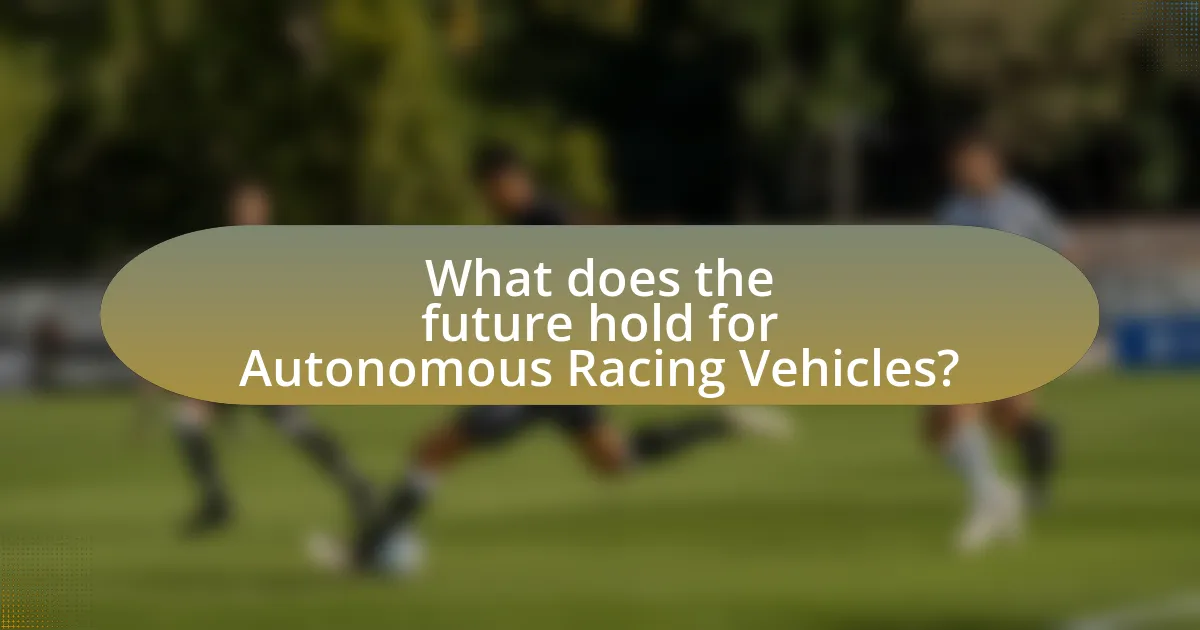
What does the future hold for Autonomous Racing Vehicles?
The future of Autonomous Racing Vehicles is poised for significant advancements driven by technological innovations and increased investment in artificial intelligence and machine learning. These vehicles are expected to enhance safety, improve performance, and revolutionize the racing experience through real-time data analysis and adaptive algorithms. For instance, companies like Waymo and Tesla are already integrating advanced sensor technologies and AI systems that allow for precise navigation and decision-making, which can be applied to racing scenarios. Furthermore, the growing interest in autonomous racing leagues, such as Roborace, showcases the potential for competitive environments that push the boundaries of these technologies, indicating a robust future for autonomous racing vehicles.
How will technology evolve in Autonomous Racing Vehicles?
Technology in Autonomous Racing Vehicles will evolve through advancements in artificial intelligence, sensor technology, and connectivity. These vehicles will increasingly utilize machine learning algorithms to enhance decision-making capabilities, enabling them to analyze vast amounts of data in real-time for improved performance. For instance, the integration of LiDAR and advanced camera systems will provide high-resolution environmental mapping, allowing for precise navigation and obstacle detection. Furthermore, the development of 5G connectivity will facilitate faster data transmission between vehicles and infrastructure, enhancing coordination and safety during races. According to a report by McKinsey, the autonomous vehicle market is expected to grow significantly, with a projected value of $557 billion by 2026, underscoring the rapid technological advancements in this field.
What advancements in AI and machine learning are expected?
Advancements in AI and machine learning expected in autonomous racing vehicles include enhanced perception systems, improved decision-making algorithms, and more efficient training methods. Enhanced perception systems will utilize advanced sensor fusion techniques to better interpret real-time data from cameras, LiDAR, and radar, allowing vehicles to navigate complex environments with greater accuracy. Improved decision-making algorithms will leverage deep reinforcement learning to optimize racing strategies, enabling vehicles to adapt to dynamic conditions on the track. More efficient training methods, such as simulated environments and transfer learning, will accelerate the development of robust AI models by allowing them to learn from vast amounts of data generated in virtual settings before being tested in real-world scenarios. These advancements are supported by ongoing research and development in the field, demonstrating a clear trajectory toward more capable and competitive autonomous racing vehicles.
How might improvements in battery technology affect performance?
Improvements in battery technology can significantly enhance the performance of autonomous racing vehicles by increasing energy density, reducing weight, and enabling faster charging times. Higher energy density allows vehicles to operate longer distances without needing to recharge, which is crucial for maintaining competitive speeds in racing scenarios. For instance, advancements in lithium-sulfur batteries have demonstrated potential energy densities of up to 500 Wh/kg, compared to traditional lithium-ion batteries, which typically offer around 250 Wh/kg. This increase can lead to lighter vehicles that maintain high performance levels. Additionally, faster charging capabilities, such as those seen in solid-state batteries, can minimize downtime during races, allowing for quicker pit stops and continuous operation. These technological enhancements directly correlate with improved lap times and overall race performance, as evidenced by ongoing research and development in the automotive industry.
What potential impacts could Autonomous Racing Vehicles have on motorsports?
Autonomous Racing Vehicles could significantly transform motorsports by enhancing safety, increasing accessibility, and revolutionizing race strategies. The implementation of autonomous technology can reduce human error, which is a leading cause of accidents in racing, thereby potentially lowering injury rates among drivers and spectators. Furthermore, autonomous vehicles can democratize motorsports by allowing individuals without extensive driving skills to participate, thus broadening the audience and increasing fan engagement. Additionally, the integration of advanced algorithms in autonomous racing can lead to more strategic and data-driven racing tactics, optimizing performance and creating new competitive dynamics. These impacts are supported by advancements in AI and machine learning, which have shown promising results in various automotive applications, indicating a strong potential for success in the racing domain.
How could they change the landscape of competitive racing?
Autonomous racing vehicles could fundamentally change the landscape of competitive racing by introducing enhanced safety, increased efficiency, and new forms of competition. These vehicles utilize advanced algorithms and sensors to navigate tracks with precision, significantly reducing the risk of human error, which has historically been a leading cause of accidents in racing. For instance, the Roborace series showcases fully autonomous electric racing cars that compete without human drivers, demonstrating the potential for a new racing format that emphasizes technology over traditional driving skills. This shift could attract a different audience and create opportunities for innovation in vehicle design and engineering, as teams focus on optimizing software and hardware for performance rather than driver skill.
What new opportunities might arise for fans and participants?
New opportunities for fans and participants in autonomous racing vehicles include enhanced engagement through interactive experiences and increased accessibility to racing events. Fans can participate in virtual reality simulations that allow them to experience races from the driver’s perspective, fostering a deeper connection to the sport. Additionally, participants can engage in data analysis and strategy development, as autonomous racing generates vast amounts of telemetry data that can be analyzed for performance insights. This shift towards data-driven participation not only democratizes access to racing but also encourages a new generation of fans to engage with technology and innovation in motorsports.
What best practices should be considered for developing Autonomous Racing Vehicles?
Best practices for developing Autonomous Racing Vehicles include rigorous testing in diverse environments, implementing advanced sensor fusion techniques, and ensuring robust safety protocols. Rigorous testing allows for the identification of potential failures and performance issues under various conditions, which is critical given that autonomous vehicles must navigate complex racing scenarios. Advanced sensor fusion combines data from multiple sources, such as LiDAR, cameras, and radar, to enhance situational awareness and decision-making capabilities. Robust safety protocols, including fail-safe mechanisms and real-time monitoring systems, are essential to prevent accidents and ensure the safety of both the vehicle and its surroundings. These practices are supported by industry standards and research, such as the SAE J3016 standard for automated driving systems, which outlines levels of automation and safety requirements.
How can developers ensure safety and reliability in their designs?
Developers can ensure safety and reliability in their designs by implementing rigorous testing protocols and adhering to industry standards. These protocols include simulation testing, real-world testing, and continuous monitoring of system performance. For instance, the ISO 26262 standard provides a framework for functional safety in automotive systems, which is crucial for autonomous vehicles. Additionally, developers can utilize redundancy in critical systems to prevent failures, as seen in aerospace engineering practices. By combining these strategies, developers can significantly enhance the safety and reliability of autonomous racing vehicles.
What strategies can be employed to address public concerns effectively?
To address public concerns effectively regarding autonomous racing vehicles, transparency and community engagement are essential strategies. Transparency involves openly sharing information about the technology, safety measures, and regulatory compliance, which can build trust among stakeholders. For instance, companies can publish safety data and performance metrics to demonstrate reliability. Community engagement includes organizing forums and discussions to gather public input and address specific fears, such as safety and job displacement. Research shows that involving the community in decision-making processes can lead to increased acceptance of new technologies, as evidenced by studies from the National Highway Traffic Safety Administration, which highlight the importance of public involvement in shaping transportation policies.
